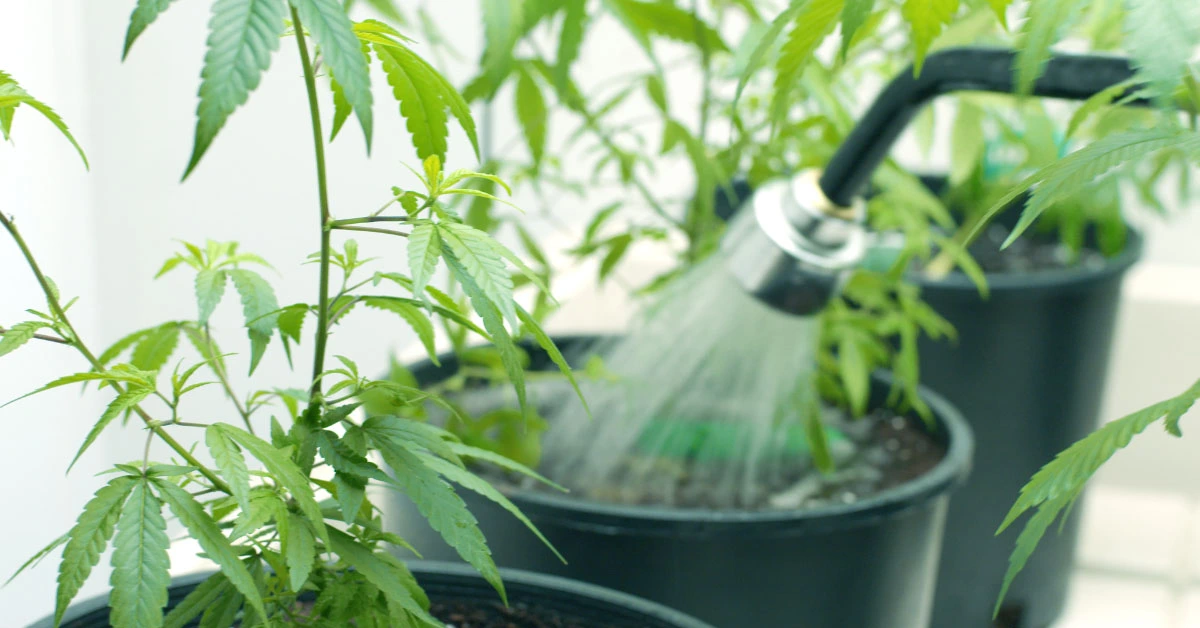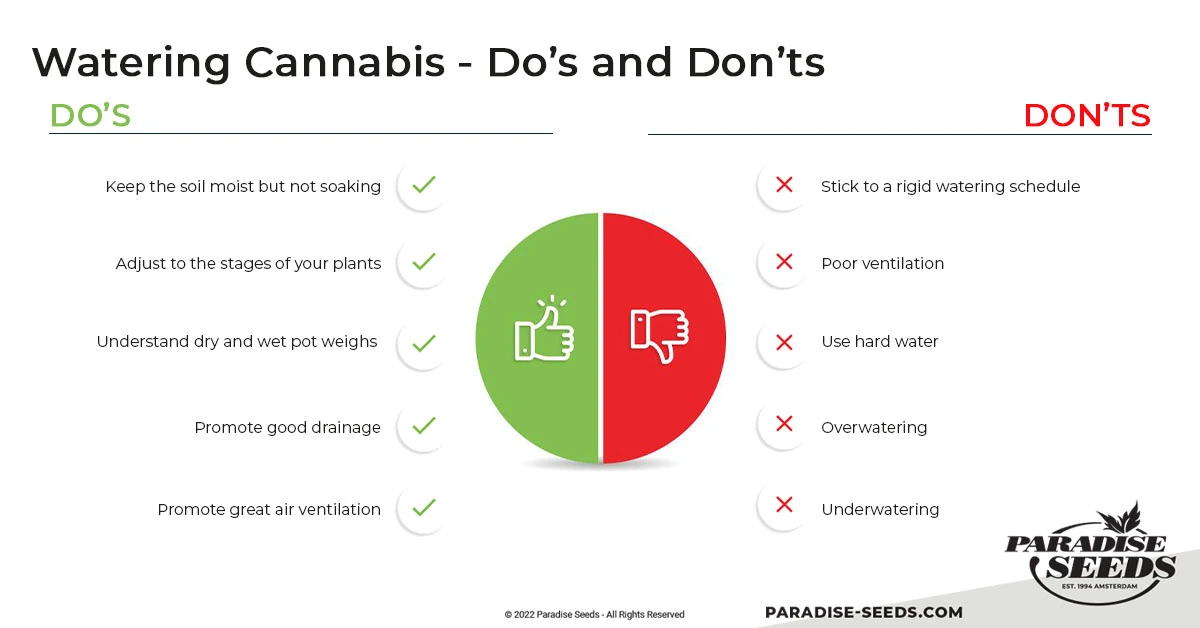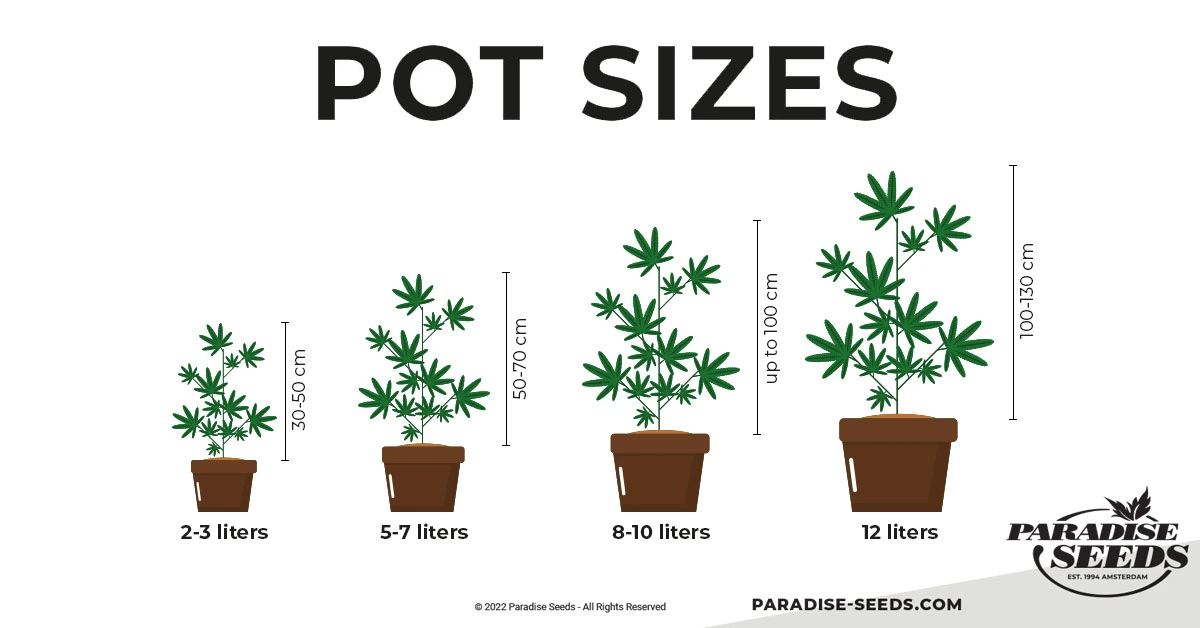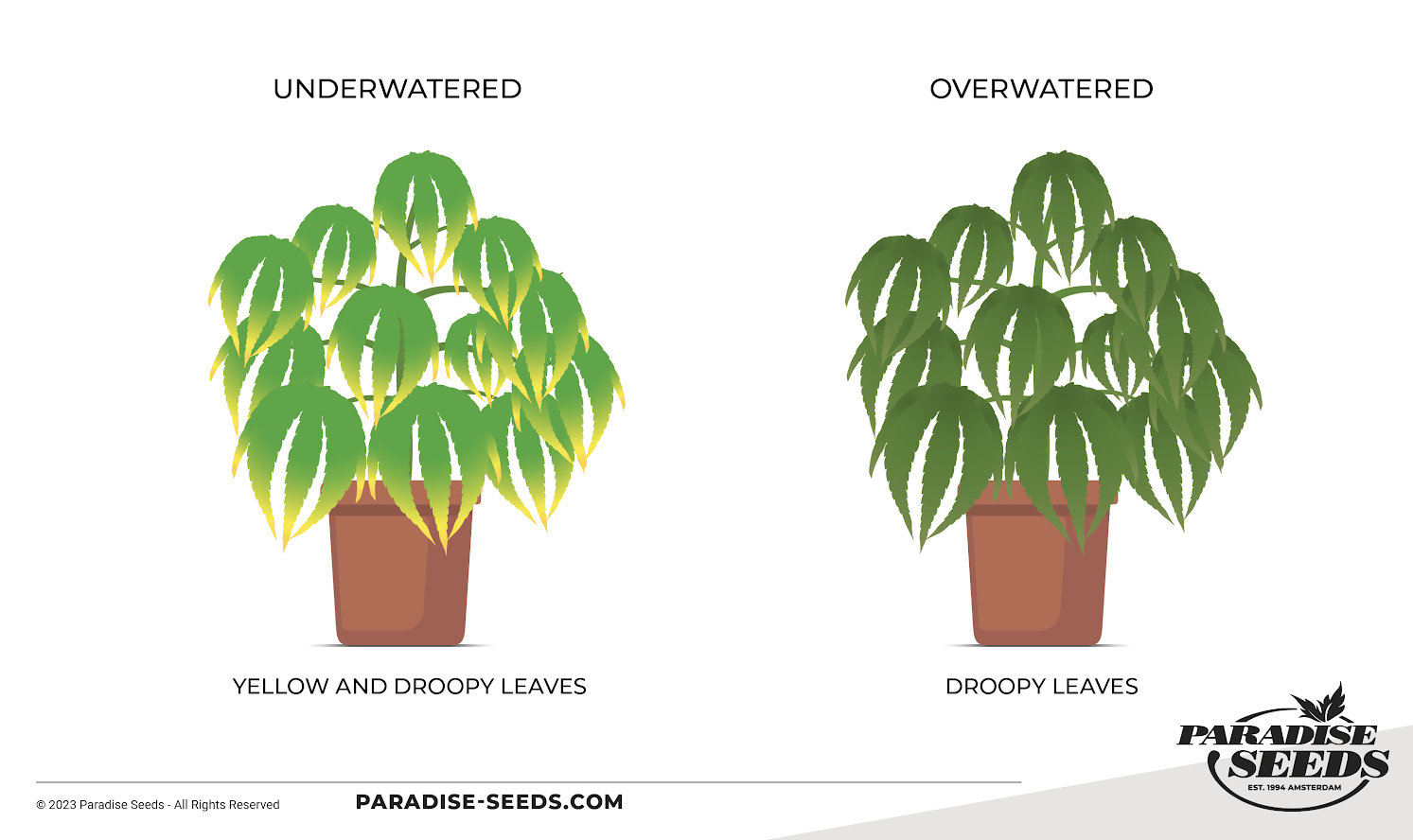It’s no surprise that cannabis plants need water to survive and thrive, but too much or too little can quickly start to have a negative effect on a grower’s crop. That is why it’s important to get the process of watering cannabis correct in order to fuel healthy growth and big yields.
This article takes a look at some dos and don’t and also provides some useful guidance about how and when to water and how to adjust your watering schedule if conditions change.
Many new growers underestimate the importance of getting the measurements right, causing themselves problems later on, but more experienced growers can also get caught out.

How often do you water cannabis plants?
The golden rule for watering cannabis is to keep the soil moist but not soaking. It is obvious that a tiny seedling needs less water than a full grown plant, but how often to water a weed plant at each of the 4 growing stages is a frequently asked question.
While some guides will suggest time periods (ie watering every couple of days), we suggest that growers are more intuitive and adjust to the needs of their plants.
For example, there is a big difference between a plant grown outdoors in northern Europe and a plant grown nearer the equator, or an indoor grow set-up in the winter or summer.
So these recommendations are drawn from what is generally agreed, when listening to the needs of your plants:
- Seed germination stage: Water a newly planted seed very lightly (a spray is best) and keep the soil moist. Do not overwater – a temptation when it is slow to show – as it is very delicate and can drown.
- Seedling stage: Water sparingly (again, the spray technique is recommended) to avoid drowning the young plant and cause its roots to rot through fungal or bacterial infection.
- Vegetative stage: Water the plant when the soil feels dry. A homemade tester is to use a finger and push into the soil between 3 -5 cm deep. If it feels dry it needs watering. A more effective (and cheap) way to measure is to use a moisture meter.
- Flowering stage: Use the same measurement system for plants in the vegetative stage.
Another popular method with plants in pots is to work out how much the pot weighs when it is dry and when it has water. Once established, one can lift or tip the pot and get a good idea if the soil is too dry.

Factors to consider when watering cannabis plants
Watering cannabis and soil drainage
Good soil is one of the keys to good management of cannabis watering. Cannabis roots are at their happiest in a light soil which is airy (to promote the circulation of oxygen) and with decent drainage.
Most growers will mix in other mediums which help with this process, such as perlite and coco coir. Some growers prefer to prepare their own soil to promote good drainage (as well as feed their plants with dry mix nutrients).
Environmental factors to consider
The big advantage of growing cannabis seeds in an indoor grow setup is being able to control the environment. However, even here factors such as humidity levels (such as in the tropics) and poor ventilation can impact on how much water plants need.
Good air ventilation is crucial to the watering process in an indoor set up as plants need to transpire water into the air. If it is already humid, then that water will just hang around. Good air circulation negates this issue.
For outdoor growing, as well as differences between growing in northern latitudes and southern latitudes, the weather can be unpredictable. Weeks of heat and sun followed by a week of cloud and rain will change the amount of water a plant needs. Wind will also dry a plant out quickly.
Outdoor cannabis growers need to adjust watering schedules accordingly – which is why moisture testing the soil is the most effective way to gauge if a plant needs water or not.
Pots and water source
As a general rule, the smaller the pot, the more frequently it will need watering. Where the water comes from is also a factor to consider. Hard water can contain harmful minerals, changes in the pH (for example this can happen if the water system is overwhelmed after a heavy storm).

Cannabis watering techniques
- Hand-watering allows the weed grower to control the amount of water each plant receives. Use a watering can or hose with a gentle spray to avoid damaging the plants.
- Drip irrigation is ideal for saving water and can be a life saver if the grower has to leave their crop for a couple of days and can’t find a friend to do the watering!
Drip irrigation systems deliver water directly to the roots. Check out this easy wick system for watering cannabis plants.
Automatic watering systems are ideal for larger grows and can save time. However, they can also be expensive and require regular maintenance. When they malfunction they are problematic.
Overwatering cannabis – What are the signs?
Overwatering should be avoided at all costs. Often the evidence is slow to materialise as the damage is being done below the surface of the soil. It is an issue because the roots become oxygen starved and effectively drown, weakening the plant and making it susceptible to disease.
Weed plants which have been overwatered will show the following signs:
- Leaves turn yellow, usually from the bottom up.
- Leaves curl over and droop down.
- The soil is very soggy.
- Growth will be slow.
- There may be signs of fungal disease.
Overwatering can be a vicious circle if you fail to read the signs correctly. Because the leaves go yellow and droop, inexperienced growers may assume they need more water, and just make the problem worse.
As well as just being too generous with watering, the main cause of overwatering cannabis is badly draining soil.
Underwatering cannabis – What are the signs?
Underwatering is not such an issue as overwatering. It is most common with weed plants that are grown in smaller pots, which will dry out quicker (especially outdoors). It is an issue because it can lead to nutrient deficiencies.
Weed plants which have been underwatered will display these signs:
- Slow or stunted growth.
- Wilting plants and drooping leaves.
It is worth noting that badly drained soil can create dry pockets, which effectively suffer from the effects of underwatering – which will kill off root hairs.
Underwatered cannabis plants require care when raising moisture levels again. Water less, then wait for it to settle for 15 – 20 minutes before watering again.

Final Thoughts on Watering Cannabis Plants
Watering cannabis plants is a critical aspect of cultivation that requires attention and care. Proper watering techniques can help to prevent nutrient deficiencies, root rot, and other problems that can reduce yield and stunt plant growth.
This article has detailed some good practices for cannabis watering, along with some dos and don’ts which will ensure healthy growth and improve yield potential.
This is a good basic guide for growers, however there is no substitute for being in tune with your plants and reading the signs. This is because every grower’s situation and environment is different. If you’re looking for high-quality cannabis strains, Paradise Seeds has a wide selection to choose from.